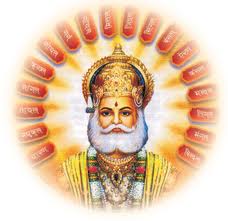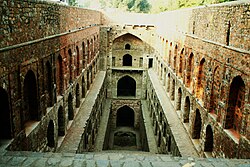Agrawal
 Maharaja Agrasen, the legendary king from whom Agrawals claim descent | |
| Regions with significant populations | |
|---|---|
| India, Pakistan | |
| Languages | |
| Hindi, Rajasthani, Punjabi, Hariyanvi | |
| Religion | |
| Majority: Vaishnava Hinduism Minority: Jainism, Islam, Christianity[1][2] |
Agrawal (anglicised as Agarwal, Agerwal, Agrawala, Agarwala, Agarwalla, Aggarwal, Agarawal, Agarawala) is a Bania community found throughout northern, central and western India, mainly in the states of Rajasthan, Haryana, Punjab, Chandigarh, Himachal Pradesh, Uttarakhand, Delhi, Chhattisgarh, Gujarat and Uttar Pradesh.[3][4] Members of the Agarwal community were also found in what are now the Pakistani provinces of Punjab and Sindh, though at the time of the partition of India, most of them migrated across the newly created border to independent India.[5][6][7] Most Agarwals follow the Vaishnava denomination of Hinduism, though some have converted to Jainism.[8][2] Agrawals are divided into eighteen exogamous clans (gotras).[citation needed] Many members of this community use their caste name Agarwal as their surname, while others use that of their gotras.[citation needed]
Members of the Agrawal community are known for their business skills and have for many years been influential and prosperous in India.[citation needed] Even in modern-day tech and ecommerce companies, they continue to dominate. It was reported in 2013, that for every 100 in funding for e-commerce companies in India, 40 went to firms founded by an Agrawal.[9]
Legend[edit | edit source]
The Agrawals claim descent from king Agrasen of the mythological Solar Dynasty.[11] List of Surnames of Agarwal community along with Gotra: https://www.allindiaagarwal.com/gotra.php/
History[edit | edit source]
Agrawals are a part of the larger Bania community, which includes other mercantile communities, such as the Maheshwari and Oswals.[3]
Migration to Rajput kingdoms[edit | edit source]
During the era of Islamic administrative rule in India, some Agarwal, as with the Saraogi, migrated to the Bikaner State.[citation needed] The Malkana include Muslim Agarwals, who converted from Hinduism to Islam during this time and were given land tracts along the Yamuna by Afghan rulers.[2]
In the early 15th century, Agrawals (sweet maker) flourished as a Halwai trader community, under the Tomaras of Gwalior.[12][full citation needed] According to several Sanskrit inscription at the Gwalior Fort in Gwalior District, several traders (Sanghavi Kamala Simha, Khela Brahmachari, Sandhadhip Namadas etc.) belonging to Agrotavansha (Agrawal clan) supported the sculptures and carving of idols at the place.[13] Historian K.C. Jain comments:
Golden Age of the Jain Digambar Temple in Gwalior under the Tomara rulers inspired by the Kashtha Bhattarakas and their Jaina Agrawal disciples who dominated the Court of father and son viz. Dungar Singh (1425-59)and Kirti Singh (1459-80) with the Poet-Laureate Raighu as their mouthpiece and spokesman, a centenarian author of as many as thirty books, big and small of which two dozen are reported to be extant today. Verify the advent of the Hisar-Firuza-based Jain Agrawals who functioned as the ministers and treasurers of the ruling family had turned the Rajput State of Gwalior into a Digambara Jain Centre par excellence representing the culture of the Agrawal multi-millionner shravakas as sponsored by them.[12]
Migration to Eastern India[edit | edit source]
Later, during the Mughal rule, and during the British East India Company administration, some Agrawals migrated to Bihar and Calcutta, who became the major component of the Marwaris.[14][page needed]
Notable Agrawals[edit | edit source]
See also[edit | edit source]
References[edit | edit source]
Notes
Citations
- ↑ Harrison, Selig S. (8 December 2015). India: The Most Dangerous Decades. Princeton University Press. p. 115. ISBN 978-1-4008-7780-5.
Some subsects of the Oswals and Agarwals were converted to Jainism in the 16th century.
- ↑ 2.0 2.1 2.2 Sikand, Yoginder; Katju, Manjari (20 August 1994). "Mass Conversions to Hinduism among Indian Muslims". Economic and Political Weekly. 29 (34): 2214–2219.
- ↑ 3.0 3.1 Hanks, Patrick (8 May 2003). Dictionary of American Family Names. Oxford University Press. p. xcvi. ISBN 978-0-19-977169-1.
The Banias of northern India are really a cluster of several communities, of which the Agarwal Banias, Oswal Banias, and Porwal Banias are mentioned separately in connection with certain surnames.
- ↑ https://www.livemint.com/Leisure/TYwWWYXGX3L72a1psxhe3N/A-history-of-the-Agarwals.html
- ↑ Gupta, Babu Lal (1987). Trade and Commerce in Rajasthan During the 18th Century. Jaipur Publishing House. p. 88.
- ↑ Das, Sibir Ranjan (2012). Resilience and Identity in Urban India: Anthropology of Barmer and Tehri. Anthropological Survey of India. p. 107. ISBN 978-81-922974-9-1.
- ↑ Gulzar Ahmed Chaudhry (4 June 2014). "Nagar Mahal – from Agarwals to Sukheras". Dawn.
- ↑ Goh, Robbie B. H. (8 February 2018). Protestant Christianity in the Indian Diaspora: Abjected Identities, Evangelical Relations, and Pentecostal Visions. SUNY Press. ISBN 978-1-4384-6944-7.
Agarwal recounts how the news of his own conversion was greeted by his grandmother in Punjab...
- ↑ Julka, Harsimran; Radhika P. Nair (12 February 2013). "Why young Aggarwals dominate India's e-commerce start-ups". The Economic Times. Delhi.
- ↑ Down to Earth: Science and Environment Fortnightly, Volume 16, Issues 16-24. Society for Environmental Communications. 2008. p. 71.
Resembling Tughlak period architectures, it was probably constructed by the Agrawal community (tracing back to Maharaja Agrasen).
- ↑ Mittal, J. P. (2006). History of Ancient India: From 4250 BC to 637 AD. Atlantic Publishers. p. 675. ISBN 978-81-269-0616-1.
- ↑ 12.0 12.1 Kashtha Sangha Bhattarakas of Gwalior and Agrawal Shravakas, Dr. K. C. Jain
- ↑ "गोपाचल के जिन मन्दिर एवं प्रतिमाएँ" (in हिन्दी). Webdunia.com. Archived from the original on 24 December 2004. Retrieved 2 June 2007.
- ↑ Hardgrove, Anne (2004). Community and Public Culture: The Marwaris in Calcutta, c. 1897–1997. Columbia University Press. ISBN 978-0-23112-216-0.
- Articles using infobox ethnic group with image parameters
- Articles with unsourced statements from August 2021
- Agrawal
- Bania communities
- Indian surnames
- Social groups of Rajasthan
- Social groups of Haryana
- Social groups of Delhi
- Social groups of Uttar Pradesh
- Social groups of Punjab, India
- Social groups of Himachal Pradesh
- Social groups of Uttarakhand
- Hindu surnames
